| OCCUPATIONAL THERAPY (MASTER) (WITH THESIS) | |||||
|---|---|---|---|---|---|
| Qualification Awarded | Program Süresi | Toplam Kredi (AKTS) | Öğretim Şekli | Yeterliliğin Düzeyi ve Öğrenme Alanı | |
| Master's ( Second Cycle) Degree | 2 | 120 | FULL TIME |
TYÇ, TR-NQF-HE, EQF-LLL, ISCED (2011):Level 7 QF-EHEA:Second Cycle TR-NQF-HE, ISCED (1997-2013): 31,72 |
|
Ders Genel Tanıtım Bilgileri
This page is still updating...
Öğrenme Etkinliği ve Öğretme Yöntemleri
Ölçme ve Değerlendirme Yöntemleri ve Kriterleri
Assessment & Grading
| Semester Requirements | Number of Activities | Level of Contribution |
| Homework Assignments | 3 | % 25 |
| Presentation | 3 | % 25 |
| Semester Final Exam | 3 | % 50 |
| total | % 100 | |
| PERCENTAGE OF SEMESTER WORK | % 50 | |
| PERCENTAGE OF FINAL WORK | % 50 | |
| total | % 100 | |
İş Yükü ve AKTS Kredisi Hesaplaması
| Activities | Number of Activities | Workload |
| Course Hours | 14 | 56 |
| Study Hours Out of Class | 16 | 64 |
| Midterms | 1 | 30 |
| Final | 1 | 30 |
| Total Workload | 180 | |
 BİLGİ PAKETİ / DERS KATALOĞU
BİLGİ PAKETİ / DERS KATALOĞU
